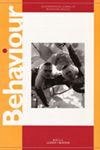反刍动物和后肠发酵器的活性不同吗?黑角马与开普山斑马的比较
IF 1
4区 生物学
Q4 BEHAVIORAL SCIENCES
引用次数: 0
摘要
最佳觅食动物应该尽量减少花在觅食上的时间,以便进行其他增强健康的活动。反刍动物更有效的消化系统,需要更少的饲料,预计在觅食方面比后肠发酵剂有优势,但这可能被它们对高质量饲料的需求所抵消。我们对比了两种相似大小的合成食草动物——反刍动物黑角马(Connochaetes gnou)和后肠发酵剂开普山斑马(Equus zebra zebra)——的活动,使用相机陷阱数据,并季节性地测试了体积需求和营养驱动的假设。斑马和角马的活动随季节变化,可能是由于资源可用性的差异。在冬季,与斑马相比,角马的放牧比例更高,这支持了营养驱动的假设,而在夏季,相反的情况发生(尽管不显著),支持了体积需求的假设。资源的季节性变化可能为反刍动物和后肠发酵菌提供了时间上的利益权衡。本文章由计算机程序翻译,如有差异,请以英文原文为准。
Do ruminants and hindgut fermenters differ in their activity? Comparison of syntopic black wildebeest and Cape mountain zebra
Optimally foraging animals should minimise time spent foraging in order to perform other fitness-enhancing activities. The ruminants’ more efficient digestive system, requiring lower volumes of forage, is predicted to provide an advantage over hindgut fermenters with respect to foraging effort, but this may be offset by their need for higher quality forage. We contrasted the activity of two similarly-sized, syntopic grazers, black wildebeest (Connochaetes gnou), a ruminant, and Cape mountain zebra (Equus zebra zebra), a hindgut fermenter, using camera trap data and tested the volume-requirement and the nutrient-driven hypotheses, seasonally. Zebra and wildebeest activity varied seasonally, potentially due to differences in resource availability. In winter, a greater proportion of wildebeest were recorded grazing relative to zebra, supporting the nutrient-driven hypothesis, whilst the inverse occurred (although not significantly) in summer, supporting the volume-requirement hypothesis. Seasonal variation in resources may provide temporal foraging trade-offs of benefits for ruminants and hindgut fermenters.
求助全文
通过发布文献求助,成功后即可免费获取论文全文。
去求助
来源期刊

Behaviour
生物-动物学
CiteScore
1.80
自引率
7.70%
发文量
44
审稿时长
3 months
期刊介绍:
Behaviour is interested in all aspects of animal (including human) behaviour, from ecology and physiology to learning, cognition, and neuroscience. Evolutionary approaches, which concern themselves with the advantages of behaviour or capacities for the organism and its reproduction, receive much attention both at a theoretical level and as it relates to specific behavior.
 求助内容:
求助内容: 应助结果提醒方式:
应助结果提醒方式:


